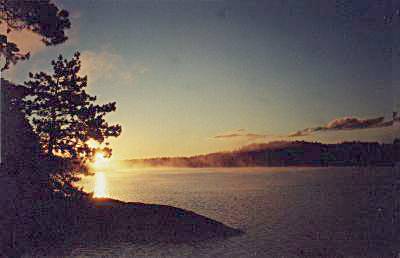 Tues.
Sept 11th.
– 13C – At 6 am the loons
bantered back and forth, their haunting wails
rebounding between the distant fog-shrouded hills
and coves. At the far end of the lake, a blazing
sun arose just as the fog lifted its cover. We
were well aware that the lakes and portages to
Threenarrows Lake would entail a great
undertaking, so we indulged in a good breakfast
and a refreshing swim before decamping our site. Tues.
Sept 11th.
– 13C – At 6 am the loons
bantered back and forth, their haunting wails
rebounding between the distant fog-shrouded hills
and coves. At the far end of the lake, a blazing
sun arose just as the fog lifted its cover. We
were well aware that the lakes and portages to
Threenarrows Lake would entail a great
undertaking, so we indulged in a good breakfast
and a refreshing swim before decamping our site.
At 9:30 am, we
found ourselves paddling across a tranquil Great
Mountain Lake. We glided by a well-kept cottage
on a point overlooking the western vistas of the
lake. Entering the southern sector of the lake,
we were met by high rock cliffs that half
encircled its bay. At the portage (10P60) to
Little Mountain Lake, John and Norm R. took out
on the right side of the small cove, not knowing
that they would have to cross a small, rocky
stream to reach the portage. 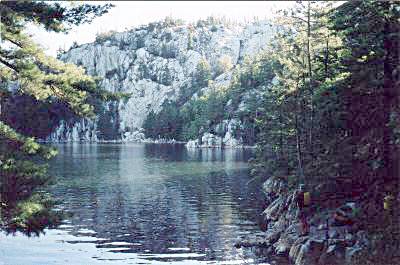 This short
trail tested our balance, strength and endurance
– the path was narrow, rocky, rutted with
roots, and sloping towards a steep embankment
which offered minimal footing, when we finally
reached it, to maneuver the canoes into the lake.
The only safeguard was a lone tree branch that
everyone held onto when making the descent down
the embankment. This short
trail tested our balance, strength and endurance
– the path was narrow, rocky, rutted with
roots, and sloping towards a steep embankment
which offered minimal footing, when we finally
reached it, to maneuver the canoes into the lake.
The only safeguard was a lone tree branch that
everyone held onto when making the descent down
the embankment.
Little Mountain
Lake was quite picturesque and the cliffs and
forests that rose from its shore created a
dramatic effect, somewhat magical – there
was a unique sense that time could have easily
stood still. The forest shadows and the
sun’s reflections upon the clear water
displayed various shades of aqua and topaz into
its depths. No one was in a hurry and we slowly
drifted towards the portage.
Our biggest task
now lay ahead of us - we were about to encounter
the first (11P950) of six portages to reach
Threenarrows Lake. As we climbed to the top of a
steep incline, we met two hikers at the
intersection of the La Cloche Trail who were
heading towards the La Cloche Mountain summit.
They were returning from Shigaug Lake and had
seen us crossing Little Mountain Lake, our green
and burgundy canoes reflecting on the aqua water.
Our original plan was to hike these two sites if
we had the time; however, our portages provided a
sufficient hiking experience for the day! Along
the portage, we came upon moose and bear dung and
we readied ourselves in the event of an unwanted
encounter. We had a pleasant return hike to
retrieve our canoes – refreshed by a cool
breeze with the sun’s rays penetrating
through the forest trees and down upon its floor;
the entire area brought to life with the sounds
of various species of birds – a vital
component in understanding the wilderness. 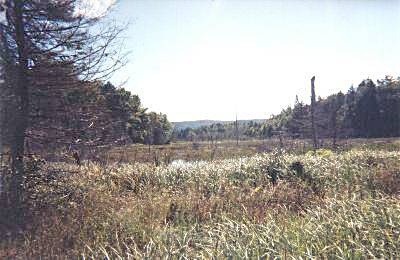 The
trail ended with a steep descent into a muddy,
wet marsh that was ideal for moose habitat. The
shallow waters allowed only one of us in each
canoe to transport small amounts of equipment to
the other side at a time. The view of the La
Cloche Mountain summit, with its reflection on
Kirk Creek was "breathtaking" - we were
in the heart of Killarney Provincial Park’s
eco-region. The
trail ended with a steep descent into a muddy,
wet marsh that was ideal for moose habitat. The
shallow waters allowed only one of us in each
canoe to transport small amounts of equipment to
the other side at a time. The view of the La
Cloche Mountain summit, with its reflection on
Kirk Creek was "breathtaking" - we were
in the heart of Killarney Provincial Park’s
eco-region.
The second portage
(12P950) with its rolling terrain, plank bridges
crossing over wet areas, and its descent to an
open grass area next to Kirk Creek proved less
difficult. After reviewing the map and taking
note of the sun’s location, we followed the
twisting, but quiet stream through a gentle
valley. Meandering through a beaver meadow among
tall grass and scrub trees, we had to portage
over three unexpected beaver dams (BD 5, 6, 7).
We enjoyed this part of our journey because we
were not on a large lake paddling against winds
and waves. There was solitude here as we slowly
paddled forward, not knowing what to expect
around the bend – our next obstacle would be
a logjam (13P35). 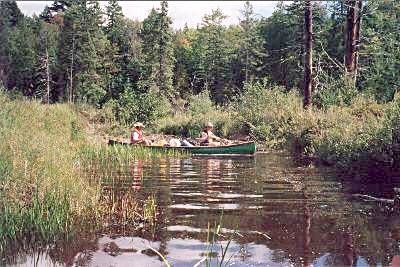 A short
distance further, we portaged (14P75) around a
waterfall where the slanting rock and pathway
made everyone cautious as we carried our loads.
The water gingerly converged over its boulders at
the foot of the waterfall and we could imagine
the spring run off cascading with greater force
and turbulence. As we scraped through overhanging
branches and noted chewed tree limbs along the
unusually high water level of the stream, we knew
that another beaver dam (BD 8) was ahead of us
– we were not disappointed! A short
distance further, we portaged (14P75) around a
waterfall where the slanting rock and pathway
made everyone cautious as we carried our loads.
The water gingerly converged over its boulders at
the foot of the waterfall and we could imagine
the spring run off cascading with greater force
and turbulence. As we scraped through overhanging
branches and noted chewed tree limbs along the
unusually high water level of the stream, we knew
that another beaver dam (BD 8) was ahead of us
– we were not disappointed!
At the end of the
wetland, we could not locate the portage (15P45)
sign because it had been removed from the tree;
this required some scouting on Wayne’s part
before he located the path and we were on our way
again. Leisurely paddling through the narrow
waterway, we watched as nature unfolded before
our eyes - a high cliff just created for a
panoramic photograph! Two unexpected portages
(16P40 & 17P50) had to be undertaken because
of low water levels – Norm R. could be heard
singing "in and out, in and out",
referring to the many stoppages along this short
passage.

Our last portage
(18P130) was around yet another beaver dam, an
impassable stream and a waterfall – the
path’s slippery, slanting rock surface and
clay mud banks forced us to gingerly maneuver our
canoes between trees and lift them high over
protruding rocks. 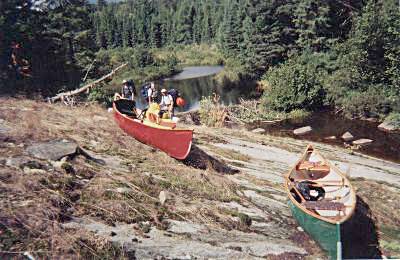 We were
thankful for the work of the beavers because
without them, water levels would have been much
lower, perhaps to the point of being impossible
to maneuver. We paddled out into a bog with logs
and stumps submerged everywhere that required
tacking left and right to avoid getting stranded. We were
thankful for the work of the beavers because
without them, water levels would have been much
lower, perhaps to the point of being impossible
to maneuver. We paddled out into a bog with logs
and stumps submerged everywhere that required
tacking left and right to avoid getting stranded.
We consulted our
map regularly and carefully as we passed by
several peninsulas and islands along the
windswept channel. Occasionally, we coasted
silently to let our eyes explore and come to
terms with the scale of this astonishing and
exhilarating landscape. Near the end of the
southeastern channel, we turned northward through
another intertwining channel that protected us
from the blustery winds and rolling waves as we
headed towards Threenarrows Lake. Again, we were
treated with several panoramic views that were
becoming so characteristic of the park.
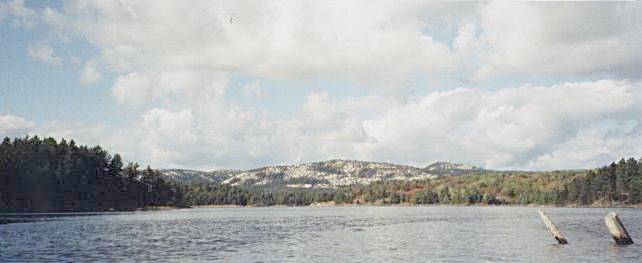
With only two
campsites available on the main part of
Threenarrows Lake, we decided not to venture to
Doris Island as planned because the lake was
heavy-laden with headwinds and whitecap waves.
Instead, we paddled out of the channel to the
middle of the lake against the high waves and
troughs and then tacked towards the safety of a
cove next to our easterly campsite (3 Site 52).
The areas for pitching our tents were small and
well rutted with roots and stones– we knew
that a good night’s sleep would be
difficult. Undeterred, we immediately set up camp
and then went for a swim and washed dirty
laundry. As we relaxed before a warm campfire and
indulged in a "medicinal sip" of Yukon
Jack to ward off the chill, we rehashed the
events of the day and all the adversity
experienced during the portages.
|